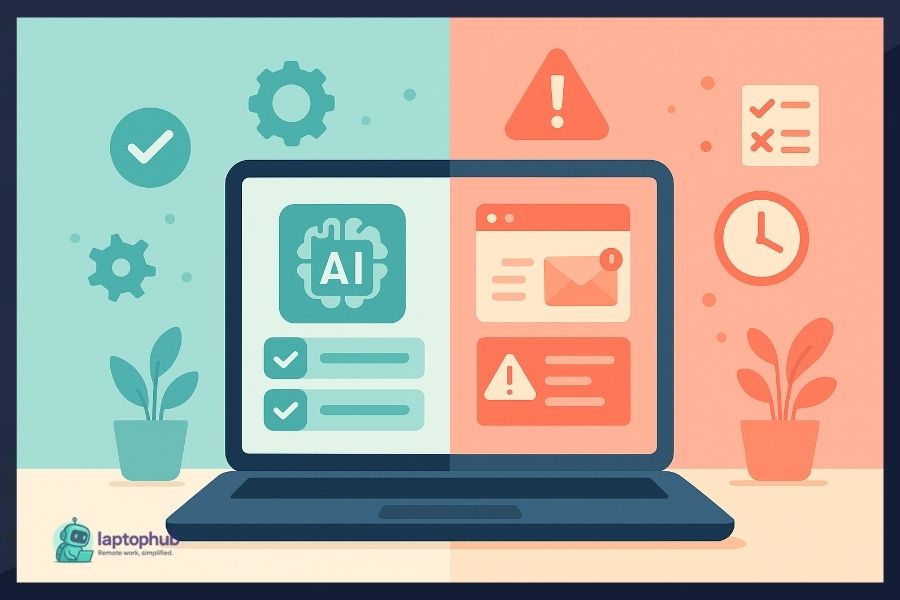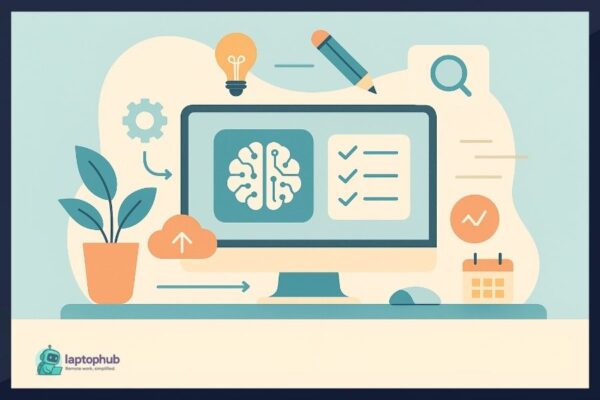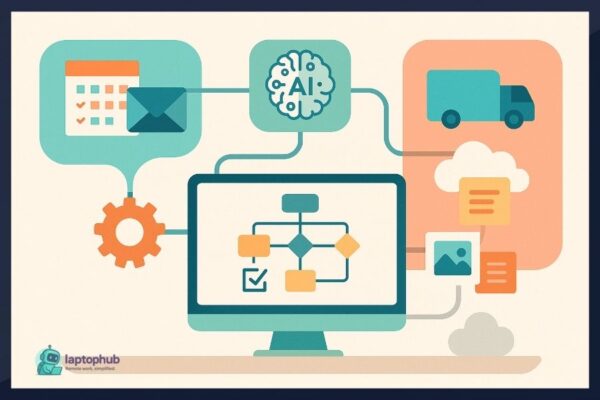Remote work has shifted from an optional perk to a common business model, and artificial intelligence (AI) is becoming a central part of how distributed teams get things done. From automating mundane tasks to providing real-time analytics, AI is transforming workflows in ways that weren’t possible even a few years ago. But just like any tool, AI has both strengths and drawbacks. Here’s an in-depth look at the real-world pros and cons of using AI in remote work environments.
💡Key takeaways:
- AI increases productivity and improves communication, project management, and cybersecurity for remote teams.
- It simplifies hiring, onboarding, and customer support by automating repetitive and data-heavy tasks.
- However, it can harm human connection, create job insecurity, and introduce bias or ethical concerns if not managed carefully.
- Successful use of AI in remote work requires thoughtful integration, human oversight, and ethical responsibility.
The Pros of Using AI in Remote Work
1. Boosted Productivity and Efficiency
AI-driven automation can take on repetitive, time-consuming tasks like scheduling meetings, sorting emails, managing files, and even generating first drafts of documents or code. This helps remote employees free up cognitive bandwidth for strategic and creative thinking.
Smart tools like Notion AI, Microsoft Copilot, and ChatGPT can write summaries, respond to emails, generate slide decks, and analyze documents in seconds. In effect, AI becomes a digital co-worker, speeding up tasks that would normally eat into a workday.
2. Improved Communication and Collaboration
Communication is often the biggest challenge for remote teams, especially those spanning multiple time zones. AI helps streamline this through features like:
- Real-time translation to bridge language gaps
- Automated meeting transcripts (e.g., Otter.ai, Zoom IQ)
- AI-driven grammar and tone suggestions (Grammarly, Hemingway)
These tools ensure that communication stays clear, consistent, and accessible. They also reduce the burden of manual note-taking, freeing team members to engage more fully in discussions.
3. More Informed Project Management
AI-enabled project management tools do more than just organize tasks. They analyze team productivity, flag potential bottlenecks, and even recommend timeline adjustments. Platforms like Monday.com, Asana, and ClickUp use machine learning to offer predictive insights—helping leaders make smarter, data-driven decisions.
In a remote environment where oversight can be difficult, these insights help maintain momentum without micromanaging.
4. Enhanced Cybersecurity Measures
Remote work increases the attack surface for cyber threats. AI helps by monitoring for abnormal behavior, identifying phishing emails, and flagging unauthorized access in real time. Tools like Darktrace and CrowdStrike use behavioral AI to adapt as new threats emerge, adding a layer of security critical for distributed teams handling sensitive data.
5. Smarter Recruitment and Remote Onboarding
Hiring and onboarding remote employees presents unique challenges, and AI is stepping in to help. Resume screening tools like HireVue or Pymetrics use natural language processing and behavioral analytics to identify high-fit candidates quickly.
On the onboarding side, AI chatbots can guide new hires through HR processes, company policies, and tools setup. This helps new remote workers get up to speed without needing round-the-clock support from human HR staff.
6. Scalable Support and Customer Service
For customer-facing remote teams, AI chatbots and virtual agents provide 24/7 support, answer FAQs, and escalate complex issues to human reps when needed. This improves response time and reduces burnout for support teams.
The Cons of Using AI in Remote Work
1. Loss of Human Connection
Remote work can already feel isolating, and excessive automation can worsen that. If feedback, recognition, or onboarding is left solely to AI, employees may feel like they’re interacting with machines instead of people.
Nuanced communication—like offering emotional support or navigating conflict—still requires human empathy. Overusing AI in these areas can erode team cohesion.
2. Job Displacement and Reduced Roles
While AI enhances productivity, it also raises valid concerns about job displacement. Administrative, customer service, and even junior creative roles are being reshaped—or replaced—by automation.
This creates uncertainty, especially for remote workers who may already feel more vulnerable due to geographic distance. Organizations need to be transparent about their use of AI and invest in reskilling to support affected employees.
3. Bias and Fairness in Decision-Making
AI tools are only as objective as the data they’re trained on. If an algorithm used in hiring or performance tracking is based on biased historical data, it can reinforce those biases.
For instance, facial recognition in video interviews may perform poorly for people of color or those with disabilities. This can create legal and ethical risks. It’s critical to audit AI systems regularly and ensure human oversight is always part of the process.
4. Privacy and Data Security Concerns
AI tools often rely on large datasets, including sensitive employee information. When used in remote environments—where devices may be personal or less secure—this opens up new vulnerabilities.
Clear data governance policies, encryption, and secure access protocols are essential. Workers should also be informed about what data is collected, how it’s used, and their rights regarding that data.
5. Tech Dependence and Inequality
AI requires a reliable tech infrastructure—fast internet, modern devices, and digital literacy. Not all remote workers have equal access to these. This creates a digital divide where some team members can’t fully leverage AI tools, putting them at a disadvantage.
Companies must consider providing stipends, equipment, or training to level the playing field and ensure inclusivity.
How to Use AI Thoughtfully in Remote Work
To harness AI’s benefits without falling into its pitfalls, companies need a strategy that blends tech with empathy. Here’s what that looks like:
- Augment, don’t replace: Let AI handle busywork, but keep humans in charge of relationship-building, decision-making, and creative thinking.
- Transparency is key: Make it clear how AI is being used, especially in hiring and performance evaluations.
- Train your team: Don’t assume employees know how to use AI tools. Provide training and create guidelines for best practices.
- Prioritize ethics and compliance: Use AI vendors that comply with privacy laws like GDPR or CCPA. Conduct regular audits.
- Balance automation with interaction: Pair AI tools with intentional team check-ins, mentoring, and collaboration opportunities.
FAQs
What are the main benefits of using AI in remote work?
AI boosts productivity, automates repetitive tasks, improves communication, and enhances project management and cybersecurity for remote teams.
What are the risks of relying on AI in a remote work environment?
Risks include job displacement, bias in decision-making, data privacy issues, and a reduction in human connection and team engagement.
Can AI fully replace remote workers?
No. While AI can handle certain tasks, human skills like empathy, creativity, and complex problem-solving remain irreplaceable.
How can companies balance AI with human input?
By using AI for support roles and repetitive work, while keeping people in charge of decision-making, mentoring, and relationship-building.
Is AI necessary for managing remote teams effectively?
Not strictly necessary, but when used well, AI can significantly improve efficiency, transparency, and scalability in remote work environments.
Final Thoughts
AI is more than a buzzword—it’s a powerful tool that’s reshaping how remote teams work. It can automate tedious tasks, improve communication, strengthen security, and make hiring more efficient. But it also comes with real challenges: from bias and privacy risks to the danger of dehumanizing work.
The key is thoughtful integration. Organizations that use AI to empower—not replace—human workers will gain a competitive edge. They’ll move faster, work smarter, and keep their people engaged.
Remote work and AI aren’t going anywhere. The companies that succeed in the future will be the ones who learn to use both with clarity, care, and purpose.





